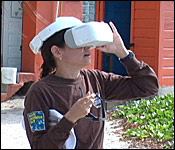
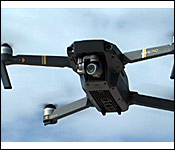
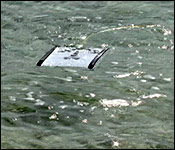 Last night, we took you to Goff's Caye for a small preview of the technologies that conservationists are now putting to use to protect the world's terrestrial and marine reserves.
Last night, we took you to Goff's Caye for a small preview of the technologies that conservationists are now putting to use to protect the world's terrestrial and marine reserves.
The Wildlife Conservation Society organized a conference for participants from 10 nations within this region to explore how best to use the latest, high-tech pieces of equipment for the benefit of the environment.
Daniel Ortiz travelled with them for their field demonstrations, and here's his story:
Daniel Ortiz reporting
Chances are you've seen aerial drones before. If not, you've heard of them. These remotely operated rotocrafts behave like mini helicopters, and are usually match-made with very powerful cameras, to provide a wide aerial view of any location.
And while they may look like toys or fun gadgets, these are tools that now being used in conservation work.
Take this one for example. It's now a standard part of the kit that rangers at the Wildlife Conservation Society make use of.
It comes with a highly portable drone, and a remote control that is connected to a smart device such the latest android phones. Chances are that your smart phone can connect to this device right now.
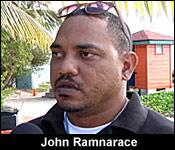 John Ramnarace - Representative, Wildlife Conservation Society
John Ramnarace - Representative, Wildlife Conservation Society
"What we have here is an aerial drone. This one is called the DGI Mavic Pro. We have been recommending this for our conservation work, both in the terrestrial and marine environments. The reason why we went with this drone is that it is very portable. You can actually fold this up, and it would esentially fit in your pants pocket."
"We find that the rangers really like this because they're already carrying a lot of load and stuff, where in the marine sector, the boat is cramped for space."
And this drone has a headpiece that connects to the drone's camera. It gives the user a live feed of what the drone's camera is seeing and recording. Think of it like virtual reality,
Where you see what the drone and its cameras are seeing as if you, yourself, are hovering in the air and observing it for yourself. Wherever you turn your head, the drone's camera responds accordingly and spins in the direction you're face.
John Ramnarace - Representative, Wildlife Conservation Society
"The reason why the head unit is used is because it gives to you a larger field of display. So, details - fine details and things like that can be seen by the rangers or whoever is operating it."
And while seeing these gadgets in action looks like more play than work, the rangers put them to very good use.
John Ramnarace
"In the marine environment, a huge drawback for rangers to be doing patrols and things like this is the cost of fuel. Fuel costs are very high to run a boat. So, what they do is they actually send the drone up into the air before they begin their patrols, and they see where there is activity on the seas. When they know where the activities are on the seas, then, they can decide if its something that they need to go and investigate."
"It makes them very efficient in the work that they're doing. There are cases where as rangers, they can't traverse easily, or it takes them a very long time to traverse these areas. Whereas, with a drone, its a matter of minutes. They also do patrol from the air to see illegal logging and other things of the sort."
And from the air, there is an underwater variant of the drone. It's a remotely operated submersible vehicle that can give the conservationists a view of marine life and habitats below water surface.
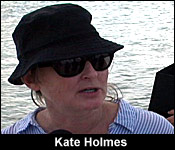 Kate Holmes - Associate Director, Global Marine Program, WCS
Kate Holmes - Associate Director, Global Marine Program, WCS
"Some people are using the word drone, an underwater drone, but essentially, it's a camera that you can move around. So, this is a really high quality camera. The camera quality is similar to what you might get with a go-pro. It might even be a higher quality camera."
"So, there's 3 different propellers that control the pitch, the angle, and the trust, and you're gonna be controlling that with the controller."
"This tether, basically, it's 25 meters. You can also buy a 100 meter tether and the unit is able to go to 100-meter depth. And it's attached to this which is called the topside unit."
"You'll see 3 lights on it, one with the power symbol, [which] shows that its one, with this wifi signal. It shows that the tablet is communicating with this topside unit, and this checkmark is ready to go. This topside unit is basically a wifi device. And in terms of controlling, it needs to be controlled by an android device. This is the more expensive option. This is a 400-dollar unit that is a tablet paired with a gaming device."
This submersible ROV is currently being tested for uses in Belize, but it is already a marine research tool all around the world.
Kate Holmes
"So, we have a project called Life Under the Ice. So, we are recording video under the arctic ice in the Bering area where we are working. And some of that has been posted, some of the initial video from that work. In Belize, they're using it for spawning aggregation work. So, it allows the team to drop the unit into a predicted spawning aggregation site to make sure they're over the right site, make sure they wanna go down here. It allows them also to look for other sites potentially, without having to dive in and out. And then, when they're ready to dive, they can dive."
"In new York, we're using it to help retrieve equipment that we're using to study whales off the coast of New York City. And so, we have acoustic monitor, and we have recording devices recording whale song. And we can use the Trident to go down and check out the units before we side divers down to retrieve units."
The participants in the regional conference field tested these gadgets in a classroom setting.
 Nicole Auil Gomez, Country Director - WCS
Nicole Auil Gomez, Country Director - WCS
"This trip to Gough's Caye was really organized for us to demonstrate some of the technologies that we've have been presenting yesterday and we will finish tomorrow. So, we are demonstrating aerial drone, we are demonstrating undersea drone and we are demonstrating the smart application."
"So, today we were able to bring everybody out of the classroom and bring them out into the field to really see what these technologies can do in real life and for them, of course, to enjoy a little bit of Belize. So, we have 10 countries here represented."
Tomorrow, we'll tell you about 2 other technologies that the WCS is making use of in Belize to document illegal fishing practices, and to aid fishermen while they're on the sea.



